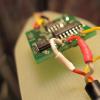How to choose a heating element for a washing machine. Heating element is the heating element of a washing machine. SMA heater service life
How to choose a heating element (heating element) for a washing machine based on the brand of equipment...
1. Seat
The main thing when selecting a heating element is that the seat fits. Fortunately, almost everyone heating element ov this place is the same. And amounts to: The width of the elastic is about 7cm, the height (thickness) is about 1.5-2cm. (depending on the thickness of the elastic band). The exception is heating elements on old washing machines that are more than 12 - 13 years old...
2. The presence of a rubber BOARD on an elastic band
The presence of a side with an elastic band - it is advisable to take into account. If instead of a heating element, which has there was no board, put the heating element with a collar, then the rubber band may not reach the fasteners... As a result, the heating element may fly out of the tank during washing. In principle, you can put a heating element without a collar, in place of a heating element with a collar, but it is not advisable... Although the craftsmen do this, they also replace the missing sensor with a coin) And so be guided by the length of the elastic band itself (after the collar).
3. Hole for sensor in flange
Some heating elements have a special hole for the sensor. On all heating elements that come with a sensor, this sensor can always be pulled out, even if it seems that it is sealed. (As far as I know, except for heating elements - Kawai)
Instead of a heating element without a hole, you can install a heating element with a hole using a special plug. (or a coin - 50 kopecks or 1 ruble)
(On LG-Samsung washing machines there are models that have heating elements with a sensor, but nothing is connected to the sensor. In this case, you can install a heating element without a hole.)
4. Heating element length
After that there is a difference in length. Heating elements are short, medium and long. It is advisable to take the length into account, but if the new heating element is a little longer or shorter than the old one, then it’s okay. You can also install a short heating element instead of a long one, but a long heating element will not fit in place of a short one (it may not fit).
5. Heating element power in Watt (W)
Next comes power. Power doesn't matter. And it can range from 800 to 3000 W. If the heating element is more powerful, then it will heat the water a little faster, and if it is less powerful, then it will heat the water a little longer. The difference will not be noticeable. BUT it is desirable that the power of the heating element does not differ more than 150-200 W
6. Shape of the heating element
Another point when selecting a heating element is its Form And Bend. Almost all heating elements are straight, but sometimes curved ones are found. Usually the bending of the composition is also something that must be taken into account.
7. Heating element coating
Some models of washing machines are equipped with heating elements with ceramic or other coatings. It is not of fundamental importance; it may last a little longer.
8. Manufacturers of heating elements
Thermowatt (the best in quality, these heating elements are stamped “made in Italy”)
IRCA (second in quality, but these heating elements come with a fuse)
Blackmann (worse heating elements, very rare)
The manufacturer does not matter, the main thing is that the heating element fits other parameters.
Brand selection process
Samsung, Indesit, Ariston - short heating elements with a hole, without a collar. Some Samsungs have ceramic heating elements. Instead of them, you can install ordinary short heating elements with a hole.
LG – short heating elements without holes. Some models come with heating elements with sensors.
Bosch, Siemens - medium heating elements with a collar and a hole.
Candy – long heating elements without a hole, with a collar.
Electrolux, Zanussi - long heating elements with a hole, with a collar.
Ardo - sometimes there are curved heating elements with or without a hole.
Older models of the brands listed above may have other heating elements. Basically, long heating elements were installed in the past. There may or may not be a hole for the sensor.
THIS LIST IS INDICATIVE. DIFFERENCES ARE POSSIBLE!
Nowadays, it is difficult to imagine the life of a modern family without such an assistant as a washing machine. This device has been reliably and permanently installed in almost all families, and it greatly makes life easier for many people. And those who are intimately familiar with the washing machine undoubtedly know that one of its significant elements is the heating element (tubular electric heater).
Because if this element fails, the machine will not function, and the program will show a control failure.

Purpose
For correct use washing machine power supply and water in the system are required. During operation, the heating element heats the water to a certain temperature (set by the washing mode).

Operating principle
A tubular heater (TEN) has a conductor inside it, and generally serves to heat water, shown in the photo. The conductor has a fairly high resistance value and is able to withstand fairly high water heating temperatures.

A dielectric with an increased thermal conductivity is located around the heating spiral and, due to it, heat is transferred to the outer shell of the steel heating element. Power is supplied via contacts soldered to the heater. To measure the heating temperature of water, there is a thermocouple.





After pressing the start button, a signal is sent from the control unit to the heating element, i.e. power begins to flow to it. As a result, it heats up to the temperature set by the set washing mode.
Having reached a certain temperature reading, the sensors are activated and send a signal to the control unit, after which the heater turns off and the water no longer heats up. Therefore, if you want to check how the heating element of your washing machine works, turn it on and see for yourself.

Technical indicators
The power of the heater is its main indicator; it is usually about 2.2 kW. If the power indicator is higher, the water will heat up faster. The characteristics of heating elements include inertia and high resistance, due to which they are resistant to sudden surges in electricity.

Its resistance depends on the power of the heater, the standard value of which varies between 20-40 Ohms. The types and sizes of heating elements for washing machines depend on their model and manufacturer.






Location of the heating element
Mainly heating elements in washing machines located at the bottom of the device, and in the event of a breakdown, you need to unfasten the cover to get to it. But some models of cars are equipped with heating elements on the side, and you will have to remove the side wall. In principle, figuring out how to remove heating elements from a washing machine is not at all difficult.

Reasons for possible breakdowns
Most popular reasons possible breakdowns Heating elements in washing machines can be:

Manufacturing defect (marriage). Any consumer can purchase a machine with a manufacturing defect; as they say, no one is insured. In this case, if the warranty period has not expired, the device can be sent to service center, where you can easily replace a defective heater with a new one.

The presence of a layer of scale on the heating element, which is one of the most common reasons damage to the heating element. Scale, enveloping the entire surface of the heater, reduces heat transfer from the heating element to the water, which leads to overheating of the heater and failure.

In addition, as a consequence, corrosion of its surface appears, further violation of the sealing of the steel coating and even, possibly, contact closure.






How to choose a heating element for a washing machine
The shape of the heating elements may vary. Most often, elements in the form of the letters W or U are found, but sometimes a spiral shape is also found.

In addition, heaters in various brands of washing machines have different types fixation and connection. Heating elements are fixed mainly using fittings with different flange diameters or terminals of different configurations.

Some heater designs are equipped with special fuses that trip when overheating and temperature sensors.

In the event of a breakdown, you will have to purchase a heater with a similar power rating and replace the heating element for the washing machine with your own hands, but at the same time you can be absolutely sure that the machine will operate as before, performing all its functions efficiently and correctly.

Where to buy?
You can repair a broken machine on your own, but to do this you will have to buy the necessary spare parts, which you will not find in a regular store. To do this, you will have to contact a service center, but the prices there are usually inflated.





The easiest and most convenient option for purchasing parts is to buy them in the appropriate online store, where you just need to indicate the model of your machine. When installing, you must use the instructions for replacing the heating element.

Life time
Of course, service life depends on many criteria: manufacturer, frequency of operation, frequency of mode used and water hardness.

If the machine is used frequently, the temperature is set high and the water hardness is quite high, then the service life of the heating element will be significantly reduced. On average, the service life of a heater can range from 2 to 10 years.


Photos of heating elements for a washing machine






Heating elements in the washing machine are consumables. And accept the fact that replacing the heating element in a washing machine is a frequent and irreversible task. In this article we will answer three FA questions: what is the reason for the breakdown of the heater in the washing machine, how to understand that it is the heating element that has been damaged, and how to choose the right heating element.
Reasons for failure of the heating element in a washing machine
The heating elements break because they become overgrown with scale. Have you looked into the teapot? Have you noticed how the metal bottom becomes covered with reddish-gray hard deposits? The same thing happens with the heater in the washing machine. The heating element operates in aggressive conditions and performs thousands of heating cycles. Its wear and tear is quite natural. And there is no need to kick the producers if the water is from the tap. Although with It’s worth noting: even distilled water produces sediment after boiling.
Signs of a broken heater in the washing machine
One day the heating element overheats and fails. What happens at the external level? A person with a sensitive nose will smell the burning smell. And those whose nose is not so sensitive, putting their hand to the “porthole”, will notice that the glass is cold, although the washing mode is set to high temperature.
Rules for selecting a heating element for a washing machine
- Power
Where can I see the heater power? - On the seat of the heating element next to the connector for the temperature sensor.
Some experts believe that power does not matter much when selecting a heating element for a washing machine. A heating element with a higher power rating heats the water a little faster, and one with a lower W-value heats the water more slowly. There is no significant difference.
- Mounting hole
Some washing machine models have a special hole for a temperature sensor, while others do not. If the car had a heater without a hole, then it can be replaced with a similar element with a hole. You can “plug” an unusable hole with a special plug.
Washing machines of the LG brand have models that have heating elements with a sensor. But the contact group is not connected to the sensor. In this case, you can take a heater without a hole.
- Height length
Tens can be roughly divided into small, medium and long.
The size of the heater is important to consider. If you purchase a heating element of a larger size, the spare part will come into contact with the walls of the tank during operation. But instead of a long heating element, you can put a short one.
- Heater shape and coating
Among the variety of straight heating elements, you will come across curved heating elements. Therefore, we take this parameter into account.
Usually the part is covered with a layer of stainless steel. But there are heating elements with a ceramic shell, which resists the destructive force of scale longer.
- Manufacturers
The most common heaters are from Thermowatt. These are leaders in quality. They are stamped "Made in Italy". Heaters for Thermowatt washing machines can be ordered in the catalog.
Heaters from IRCA are considered second in quality.
Blackmann - heating elements from these manufacturers are not worth purchasing (they have a bad reputation).
Selecting heating element by brand
Samsung, Indesit, Ariston washing machines usually come with short heating elements with a hole for a temperature sensor.
LG fits short heaters with or without a hole.
For Bosch and Siemens machines - medium-length elements with a hole.
Long heating elements without holes are used for Candy.
Heaters measuring about 190-195 mm with space for a temperature sensor would be ideal for Electrolux and Zanussi automatic machines.
For Ardo washing machines - in models of this brand there are curved heating elements with or without a hole.
How to choose a heating element (heating element) for a washing machine according to the brand of equipment.
1. Seat
The most important thing when selecting a heating element is that the seat fits. Almost all heating elements have the same place. The exception is heating elements on old washing machines that are more than 12 - 13 years old. 
2. Presence of a collar
The presence of a collar must be taken into account. If instead of a heating element that did not have a collar, you put a heating element with a collar, then this heating element may fly out of the tank during washing. In principle, it is possible to install a heating element without a collar in place of a heating element with a collar, but it is not advisable.
3. Hole for sensor
Some heating elements have a special hole for the sensor. On all heating elements that come with a sensor, this sensor can always be pulled out, even if it seems that it is sealed.
Instead of a heating element without a hole, you can install a heating element with a hole using a special plug.
There are models on LG washing machines that have heating elements with a sensor, but nothing is connected to the sensor. In this case, you can install a heating element without a hole.
4. Heating element length
After that there is a difference in length. Heating elements are short, medium and long. It is advisable to take the length into account, but if the new heating element is a little longer or shorter than the old one, then it’s okay. You can also install a short heating element instead of a long one, but a long heating element will not fit in place of a short one (it may not fit).
5. Heating element power
6. Shape of the heating element
Another point is the shape of the heating element. Almost all heating elements are straight, but sometimes curved ones are found. This must also be taken into account.
7. Heating element coating
Some models of washing machines are equipped with heating elements with ceramic or other coatings. It is not of fundamental importance; it may last a little longer.
8. Manufacturers of heating elements
- Thermowatt (the best in quality, these heating elements are stamped “made in Italy”)
- IRCA (second in quality, but these heating elements come with a fuse)
- Blackmann (worse heating elements, very rare)
The manufacturer does not matter, the main thing is that the heating element fits other parameters.
Brand selection process
- Samsung, Indesit, Ariston - short heating elements with a hole, without a collar. Some Samsungs have ceramic heating elements. Instead of them, you can install ordinary short heating elements with a hole.
- LG – short heating elements without holes. Some models come with heating elements with sensors.
- Bosch, Siemens - medium heating elements with a collar and a hole.
- Candy – long heating elements without a hole, with a collar.
- Electrolux, Zanussi - long heating elements with a hole, with a collar.
- Ardo - sometimes there are curved heating elements with or without a hole.
- Older models of the brands listed above may have other heating elements. Basically, long heating elements were installed in the past. There may or may not be a hole for the sensor.
How to choose a heating element (heating element) for a washing machine according to the brand of equipment...
1. Seat
The main thing when selecting a heating element is that the seat fits. Fortunately, almost everyone heating element ov this place is the same. And amounts to: The width of the elastic is about 7cm, the height (thickness) is about 1.5-2cm. (depending on the thickness of the elastic band). The exception is heating elements on old washing machines, which are more than 12 - 13 years old...
2. The presence of a rubber BOARD on an elastic band
The presence of a side with an elastic band - it is advisable to take into account. If instead of a heating element, which has there was no board, put the heating element with a collar, then the rubber band may not reach the fasteners... As a result, the heating element may fly out of the tank during washing. In principle, you can put a heating element without a collar, in place of a heating element with a collar, but it is not advisable... Although the craftsmen do this, they also replace the missing sensor with a coin) And so be guided by the length of the elastic band itself (after the collar).
3. Hole for sensor in flange
Some heating elements have a special hole for the sensor. On all heating elements that come with a sensor, this sensor can always be pulled out, even if it seems that it is sealed. (As far as I know, except for heating elements - Kawai)
Instead of a heating element without a hole, you can install a heating element with a hole using a special plug. (or a coin - 50 kopecks or 1 ruble)
(On LG-Samsung washing machines there are models that have heating elements with a sensor, but nothing is connected to the sensor. In this case, you can install a heating element without a hole.)
4. Heating element length
After that there is a difference in length. Heating elements are short, medium and long. It is advisable to take the length into account, but if the new heating element is a little longer or shorter than the old one, then it’s okay. You can also install a short heating element instead of a long one, but a long heating element will not fit in place of a short one (it may not fit).
5. Heating element power in Watt (W)
Next comes power. Power doesn't matter. And it can range from 800 to 3000 W. If the heating element is more powerful, then it will heat the water a little faster, and if it is less powerful, then it will heat the water a little longer. The difference will not be noticeable. BUT it is desirable that the power of the heating element does not differ more than 150-200 W
6. Shape of the heating element
Another point when selecting a heating element is its Form And Bend. Almost all heating elements are straight, but sometimes curved ones are found. Usually the bending of the composition is also something that must be taken into account.
7. Heating element coating
Some models of washing machines are equipped with heating elements with ceramic or other coatings. It is not of fundamental importance; it may last a little longer.
8. Manufacturers of heating elements
Thermowatt (the best in quality, these heating elements are stamped “made in Italy”)
IRCA (second in quality, but these heating elements come with a fuse)
Blackmann (worse heating elements, very rare)
The manufacturer does not matter, the main thing is that the heating element fits other parameters.
Brand selection process
Samsung, Indesit, Ariston - short heating elements with a hole, without a collar. Some Samsungs have ceramic heating elements. Instead of them, you can install ordinary short heating elements with a hole.
LG - short heating elements without holes. Some models come with heating elements with sensors.
Bosch, Siemens - medium heating elements with a collar and a hole.
Candy - long heating elements without a hole, with a collar.
Electrolux, Zanussi - long heating elements with a hole, with a collar.
Ardo - sometimes there are curved heating elements with or without a hole.
Older models of the brands listed above may have other heating elements. Basically, long heating elements were installed in the past. There may or may not be a hole for the sensor.
THIS LIST IS INDICATIVE. DIFFERENCES ARE POSSIBLE!
Read also...
- Cadaques in Spain. My review and photo. Cadaques, Catalonia Cadaques Spain how to get there from Barcelona
- Cart for an online store at the front or Writing modular javascript
- Falling snow on jQuery or html New Year greeting card template
- Where to see what version of Android is installed on an Honor and Huawei phone How to find out the Huawei serial number





















